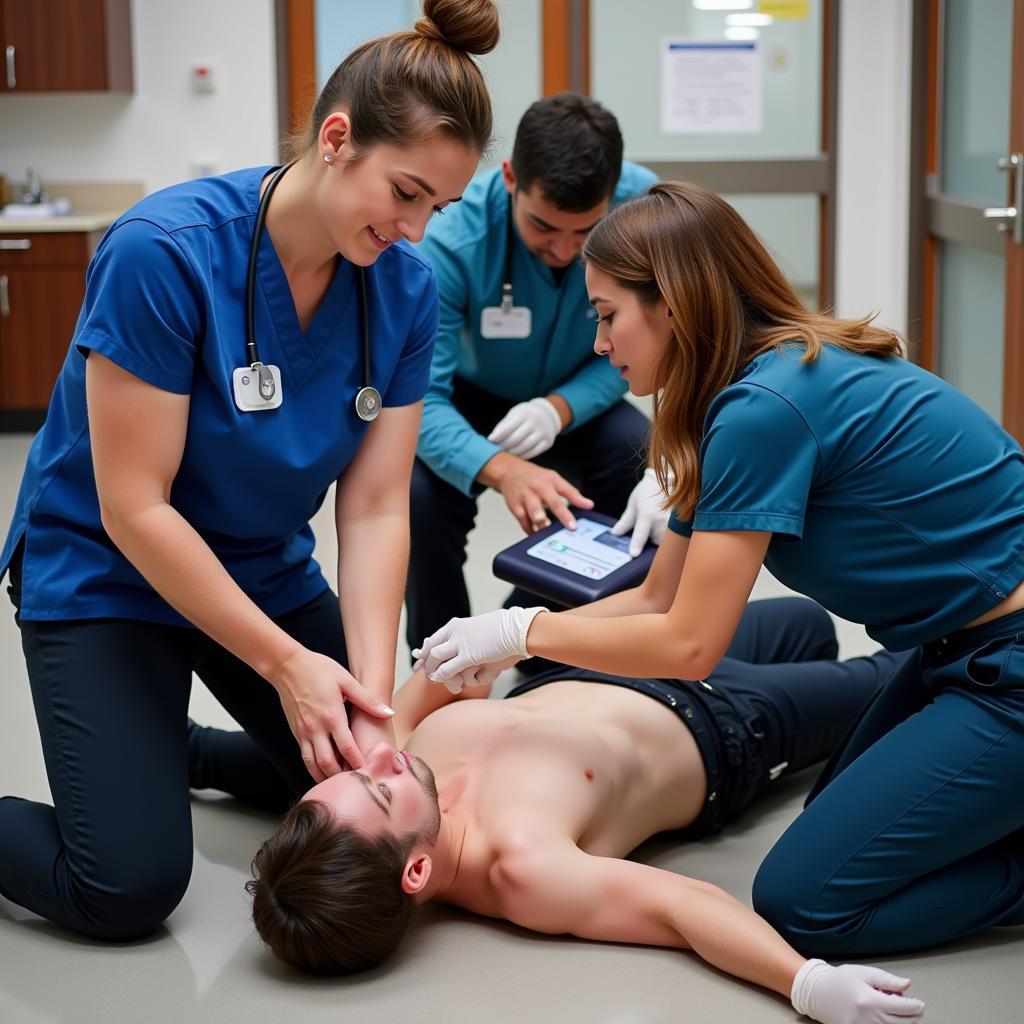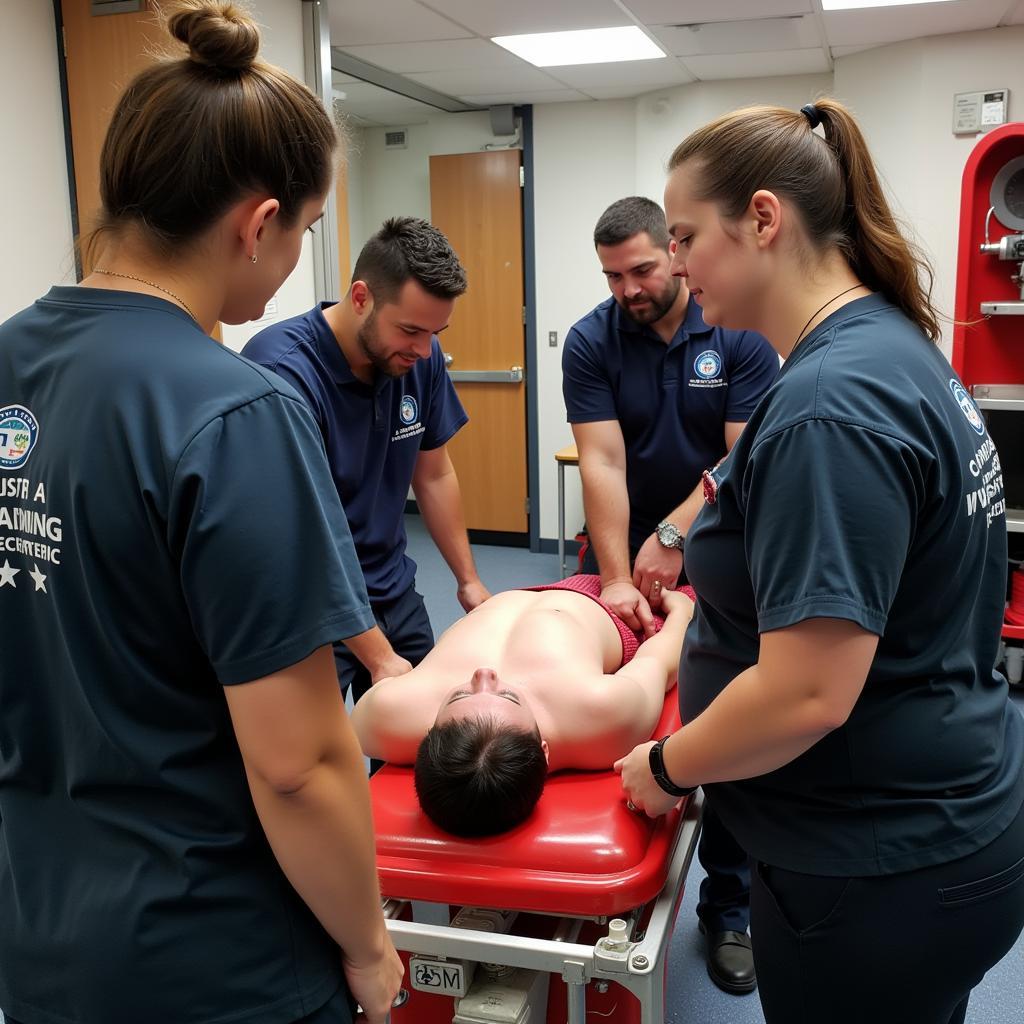The “in-hospital cardiac chain of survival” refers to a series of crucial steps taken by healthcare professionals within a hospital setting to maximize the chances of survival for a patient experiencing cardiac arrest. This coordinated response system is crucial for improving outcomes and saving lives.
Understanding the Importance of the In-Hospital Cardiac Chain of Survival
Cardiac arrest occurs when the heart suddenly stops beating effectively, leading to a loss of blood flow to the brain and other vital organs. Time is of the essence in these situations, and immediate, well-coordinated action is critical to increasing the likelihood of survival and minimizing potential long-term complications.
The Links in the In-Hospital Cardiac Chain of Survival
While the specific protocols might vary slightly depending on the healthcare facility, the in-hospital cardiac chain of survival generally consists of the following links:
- Early Recognition and Activation of the Emergency Response System: The first step involves the prompt identification of cardiac arrest. This often relies on continuous monitoring of patients considered high-risk, coupled with staff awareness of the signs and symptoms of cardiac distress. Immediately upon recognition, the hospital’s emergency response system should be activated, summoning a team of trained professionals to the patient’s side.
 Early Recognition of Cardiac Arrest
Early Recognition of Cardiac Arrest - Early High-Quality CPR: Cardiopulmonary resuscitation (CPR) is a critical lifesaving technique that helps maintain blood flow and oxygen delivery to the brain and other organs until more advanced medical interventions can be initiated. Effective CPR involves chest compressions and rescue breaths, performed by trained personnel.
 High-Quality CPR in a Hospital Setting
High-Quality CPR in a Hospital Setting - Rapid Defibrillation: Defibrillation is a procedure that delivers an electric shock to the heart, aiming to restore a normal heart rhythm. It is particularly effective for certain types of irregular heartbeats, such as ventricular fibrillation, which are commonly associated with cardiac arrest. Quick access to defibrillators and prompt delivery of the shock are paramount.
- Effective Advanced Life Support: Once the initial emergency response team arrives, they will provide more advanced life support measures, such as:
- Airway management: This may involve inserting a breathing tube to ensure the patient has an open airway.
- Intravenous medications: Medications may be administered to help restart the heart, stabilize blood pressure, or correct underlying medical conditions.
- Post-Cardiac Arrest Care: If the patient’s heart rhythm is restored, they will require ongoing care and management to optimize their recovery and prevent further cardiac events. This may include:
- Close monitoring in an intensive care unit (ICU)
- Medications to regulate heart rhythm, blood pressure, and other vital signs
- Diagnostic tests to determine the underlying cause of the cardiac arrest
- Cardiac catheterization or other procedures to address any blockages or abnormalities in the heart
The Role of Training and Teamwork
The successful implementation of the in-hospital cardiac chain of survival hinges on a highly trained and coordinated team of healthcare providers. Regular simulations and drills are essential for reinforcing protocols, improving communication, and ensuring that everyone involved is prepared to act swiftly and efficiently during an actual cardiac arrest.
 Medical Team Participating in a Cardiac Arrest Simulation
Medical Team Participating in a Cardiac Arrest Simulation
Improving Patient Outcomes
Hospitals that prioritize the in-hospital cardiac chain of survival and invest in ongoing training and quality improvement initiatives often see significant improvements in survival rates for patients experiencing cardiac arrest.
Conclusion
The in-hospital cardiac chain of survival represents a coordinated effort to provide immediate, life-saving care to patients experiencing cardiac arrest. By adhering to established protocols, healthcare professionals can significantly improve the odds of survival and enhance patient outcomes. Continuous training, teamwork, and a commitment to excellence are essential for optimizing the effectiveness of the in-hospital cardiac chain of survival.
Do you want to learn more about how our hospital prioritizes cardiac care? First link in out of hospital chain of survival. We also have resources on the pediatric out of hospital chain of survival steps.
Need Immediate Assistance?
Call us at: 02437655121
Email us at: [email protected]
Visit us at: Số 298 Đ. Cầu Diễn, Minh Khai, Bắc Từ Liêm, Hà Nội, Việt Nam
Our dedicated care team is available 24/7 to assist you.